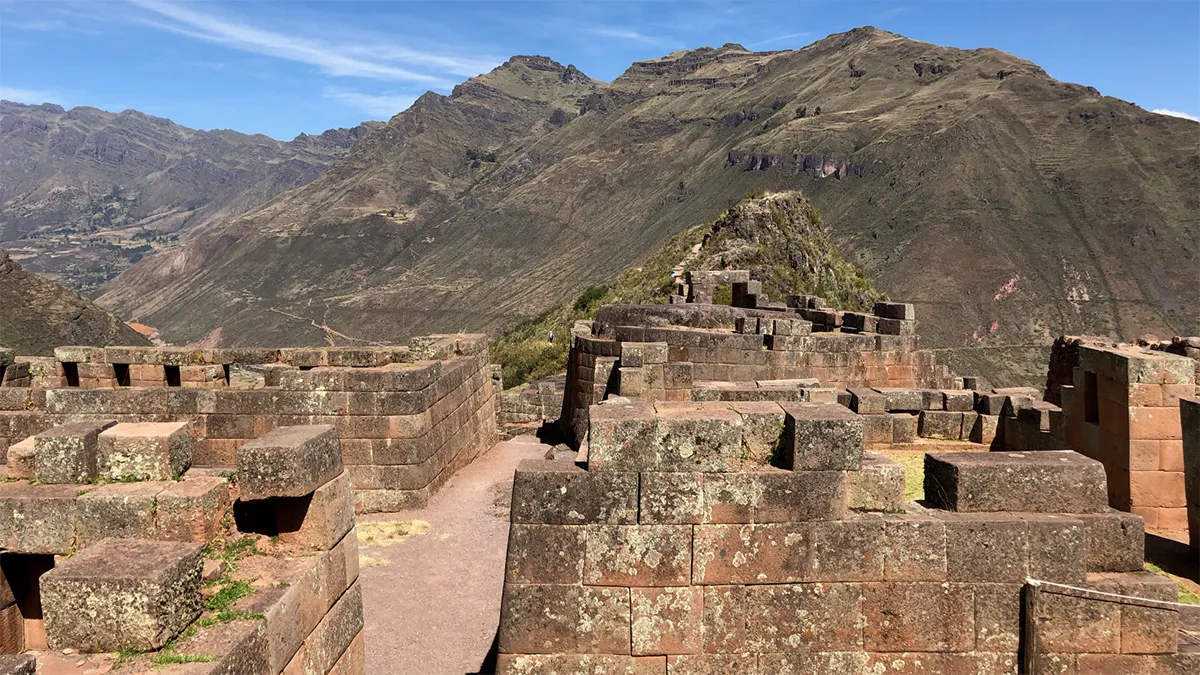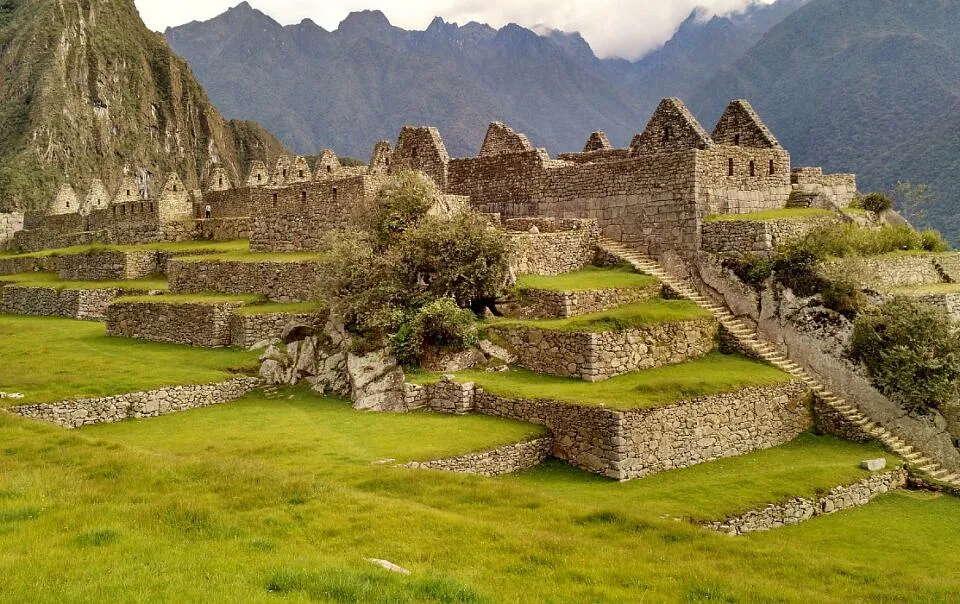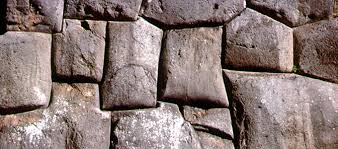A second major influence on Inca architecture came from the Wari culture, a civilization contemporary to Tiwanaku. According to Ann Kendall, the Huari introduced their tradition of building rectangular enclosures in the Cusco region, which formed a model for the development of the Inca kancha. There is evidence that such traditions were preserved in the Cusco region after the decline of the Wari as is attested by the enclosures found at sites such as Choquequirao (Chuqi K'iraw), 28 kilometers southeast of the Inca capital.
Masonry and construction methods
Extraordinary manpower would have been necessary for large construction projects. The Inca Empire employed a system of tribute to the Inca government in the form of labor, called Mit'a that required all males between 15-50 to work on large public construction projects. Hyslop comments that the 'secret' to the production of fine Inca masonry “…was the social organization necessary to maintain the great numbers of people creating such energy-consuming monuments.” Spanish Chronicler Pedro Cieza De Leon wrote that Pachacuti "ordered 20,000 men sent in from the provinces" for the construction of Sacsayhuamán.
Water engineer Ken Wright estimates that 60 percent of the Inca construction effort was underground. The Inca built their cities with locally available materials, usually including limestone or granite. To cut these hard rocks the Inca used stone, bronze or copper tools, usually splitting the stones along natural fracture lines.
The stones were moved by teams of men pulling with ropes, as shown in the drawings of chronicler Felipe Guaman Poma de Ayala. Cieza De Leon also writes "4000 of them quarried and cut the stones; 6000 hauled them with great cables of leather and hemp." Similar ropes used on Incan suspension bridges were made with ichu grass. Small ropes of these materials have been shown to support a load of 4000lbs, and larger ropes may have been able to hold up to 50,000lbs.[29] The stones were rolled to their positions using wooden beams on earth ramps. An unfinished chullpa in Sillustani still has a ramp in place. Father Cobo saw Incan builders using a similar ramp during the construction of the Cusco Cathedral.
It is speculated that stones were initially fit using hammerstones. The stones would then be lifted into place with a rope sling tied to bosses near the stone's base, many of which can still be seen on Incan walls. Adjustments could have been performed by eye alone or aided by the use of a compressible dust, such as the dried sap of the llawlli plant (Barnadesia horrida). Abrasive finishers, such as sand or pumice, may also have been used.
Additional surface smoothing near the edges of blocks has been attributed by some researchers to a chemical etching "mortar" composed of pyrite mining slurry and plants containing calcium oxalate. Some species of bacteria from the genus Thiobacillus are able to process sulfidic minerals and produce sulfuric acid as a byproduct; complexation with oxalate increases the etching potential of the mixture. This would correspond with both contemporary descriptions of the Incan masonry process and regional folklore suggesting that Incan masons and a local bird species, the pito, were capable of softening rocks with a local herb.
Usually the walls of Incan buildings were slightly inclined inside and the corners were rounded. This, in combination with masonry thoroughness, led Incan buildings to have a peerless seismic resistance thanks to high static and dynamic steadiness, absence of resonant frequencies, and stress concentration points. During a small or moderate earthquake, masonry was stable; during strong earthquakes, stone blocks have been observed "dancing" and settling into their original positions afterwards.
Another building method was called "pillow-faced" architecture. The Incas would sand large, finely-shaped stones which they would fit together in jigsaw-like patterns. Pillow-faced architecture was typically used for temples and royal places like Machu Picchu.
Ashlar masonry was used in the most sacred, elite Incan structures; for example, the Acllawasi ("House of the Chosen Woman"), the Coricancha ("Golden Enclosure") in Cuzco, and the Sun Temple at Machu Picchu. Thus it seems that ashlar may have been more greatly valued by the Inca, perhaps considered more difficult than polygonal ("pillow-faced") masonry. Though polygonal masonry may be aesthetically more impressive, the facture of ashlar masonry tends to be unforgiving to mistakes; if the corner of a polygonal masonry block is broken, it can be reshaped to fit, but ashlar masonry blocks must remain intact.
Symbolism and patronage
Aesthetics: Combining the Built and Natural Environments
Inca architecture is strongly characterized by its use of the natural environment. The Inca managed to seamlessly merge their architecture into the surrounding land and its specificities. At its peak, the Inca Empire spanned from Ecuador to Chile. Yet despite geographic variances, Inca architecture remained consistent in its ability to visually blend the built and natural environment.
In particular, Inca walls practiced mortarless masonry and used partially worked, irregularly shaped rocks to complement the organic qualities and diversity of the natural environment. Through the dry fitted masonry techniques of caninacukpirca, the Incas shaped their stone to conceal natural outcrops, fit tight crevices, and ultimately incorporate the landscape into their infrastructure.
The Inca also used natural bedrock as their structural foundations (to help keep the buildings stable). This pragmatically stabilized their structures built in the Andes mountain range of South America, while aesthetically disguising the boundaries between mountain and edifice. In combination, the diversity of stone shape, materiality, and facture all furthered the naturalistic illusion of the Inca's built environment.
Politics : Expansionist and Subservient Ideologies
Inca employment and integration of the natural environment into their architecture played an essential role in their program of civilizational expansion and cultural imperialism. Patronage of powerful elites and rulers of the Inca empire was a major impetus behind the construction of Inca structures, and much of the remaining architecture we see today was most likely royal estates or mobile capitals for Sapa Inca to inhabit. The Sapa Inca naturalized and asserted their political rule through their palaces' aesthetic appeal to a reciprocal relationship between their imperialism and the earth itself.

The blended, architectural aesthetic colored their political expansion in a sense of inseparable, timeless, and spiritual authority. For example, in the royal estate of Chinchero, the Incas adapted their large-scale earthwork and massive stone construction to the land's dramatically steep valley in order to create intense, visual drama. Similarly to the architecture of other mountainous Inca citadels, such as Machu Picchu, the Chinchero estate's dynamic construction into the severe landscape demonstrated the raw, physical power of the Incas, and projected an authoritative aura for those who approached.


















No comments:
Post a Comment